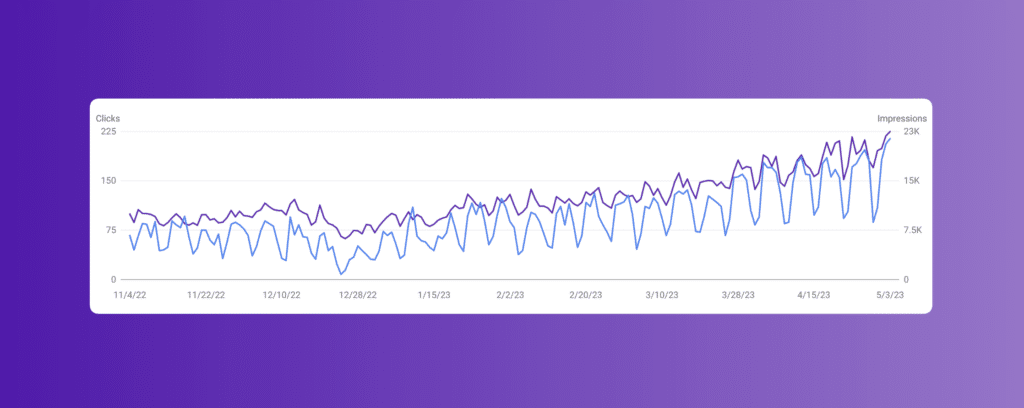Many businesses love creating content, but not enough take the time to properly go back and work towards pruning, improving, and driving eyeballs to the content they already have.
Content audits are an essential tool that every SaaS marketing team should be leveraging, rather than focusing on continually just pumping out content.
In this article, we will explore how a content audit can effectively purge unnecessary content and boost your website ranking.
Before diving into the process of performing a content audit, it’s essential to understand the why behind conducting one.
A content audit allows you to evaluate all existing content on your website critically.
By analyzing web pages, landing pages, blog posts, and other forms of content, you can identify those pieces that are outdated, underperforming, and in need of improvement.
This results in better performance and higher search engine rankings:

The benefits of a content audit extend beyond just improving search engine rankings:
A content audit can also help improve the user experience on your website.
By ensuring that all information is relevant and up to date, you can provide your users with the most accurate and helpful information possible.
This can lead to increased user engagement, higher conversion rates, and more satisfied customers.
Everything that search engines like Google want to see.
In addition to improving user experience, a content audit can also help you identify gaps in your content marketing strategy.
By analyzing your existing content, you can determine which topics and themes are already covered and which areas need more attention.
This can help you create a more comprehensive and effective content marketing plan that addresses the needs and interests of your target audience.
A SaaS content audit serves to enhance the quality and relevance of a website’s content, such as blog posts and landing pages, for its target audience.
It examines the site’s content to reveal any issues such as gaps, outdated material, or duplicated information that may negatively impact search engine optimization (SEO) and user engagement.
Though time-consuming, a SaaS content audit can drive a real impact on right-fit website traffic and conversions.
Here are the key advantages of conducting a SaaS content audit:
Conducting a content audit for your SaaS business every 3-6 months is an effective strategy for ensuring that your content remains up-to-date, captivating, and resonating with your target audience.
Giving yourself this time frame allows for adjustments in response to user behavior changes and market trends. As this process can be time-consuming, setting aside adequate time for preparation is essential.
The ideal frequency for content audits depends on factors such as the size of your content library, content creation frequency, and industry shifts.
By consistently monitoring content performance and user feedback, you can discern the necessity for more frequent audits and updates.
Before initiating a content audit, consider the following questions:
It’s important to remember that the actual duration of the content audit isn’t as critical as the actions you implement based on the information gathered. Some potential outcomes of your content audit include:
The first crucial step when carrying out a content audit is understanding your target audience.
This helps ensure that you maintain a consistent voice and tone throughout your entire website and gather data specific to your target audience to inform your future content marketing efforts.
Mapping out your customer journey and knowing the intended purpose of each content piece is essential.
Before beginning the audit process, establish the goals of your content audit.
Are you aiming to improve lead generation, increase customer retention, or enhance brand awareness?
Defining your objectives helps align the audit process with your overall business strategy.
Begin collecting and categorizing the content on your website, including blog posts, articles, videos, white papers, how-to guides, interactive quizzes, and more.
This can be done by leveraging a crawling tool such as Screaming Frog, or SiteBulb to run a crawl of your website and pull back every single page on the website.

This will create a comprehensive content inventory, which you can then begin to evaluate.
Use content audit tools to compile a list of all the URLs on your website.
Systematically audit each URL to determine whether it needs to be deleted, updated, or redirected.
This is an opportunity to identify any broken links or dysfunctional pages.
Each page will need to be categorized to implement the corresponding changes, whether it’s repurposing old content, adding new sections, or deleting an entire webpage.
The data gathered during the audit will inform these decisions.
After completing the audit, dive into the performance of your content.
Review engagement metrics to determine the value and success of your content.
Examples of SaaS SEO metrics to monitor include:
Want a fast way to conduct a content audit on the fly, vs. running out a full content audit?
Here’s how we’d approach it:
First – stop creating new content.
Instead, do this:
1. Go to Google Search Console
2. Filter on the date range for the last 3 months
3. Click export
4. Filter the output by positions 4-20
5. Highlight important queries
Want to map the query to the existing page(s) that are ranking?
6. Go back to Search Console, filter on the query, add the query, and click pages.
Multiple pages targeting the same keyword?
Consolidate into one page.
For the other highlighted queries, focus on making improvements to the pages to drive rankings:
How? Run a Google search for your primary topic. Examine the top 3-5 results. Take a new angle, updated information, and better content.
This is how you get more out of your existing content, without spending time and money on building more.

Running a content audit is beneficial, and is something that every SaaS marketing team should be focused on doing at least bi-annually.
Conduct audits help to keep a pulse on your content efforts, and force you to continually update and mak changes that keep your overall content strategy in-line, and make changes that have an actual business impact on real revenue metrics.
Founder of Rock The Rankings, an SEO partner that helps B2B SaaS brands crush their organic growth goals. An avid fan of tennis, and growing micro-SaaS businesses on the weekend. 2x SaaS Co-Founder – Currently working to build and scale Simple Testimonial.
Book a 1-on-1 intro call with our founder that includes a FREE custom marketing plan. Start growing faster, today.